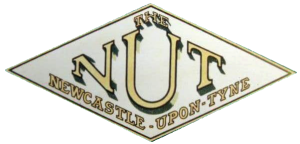


1911 The company started up with the backing of the Angus Sanderson firm and their manager, Hugh Mason.
1912 The first machines had handle starting and Hugh Mason's 'HM' monogram. Later he built bikes under the names Jesmond and Bercley Bercley until he used NUT in 1912. The name was promoted when a machine, fitted with a 344cc Moto-Reve engine and ridden by Robert Ellis, finished sixth in the Junior TT.
1913 Only JAP engines were used in the range, these were a 3½ hp single, plus 2.75 and 3¼ hp V-twins. Two 345cc twins were entered in the Junior TT that year, to be placed first and eighth.
1914 Other racing successes followed and the company moved to larger premises.
1916 The firm had concentrated on building up a range of V-twins which now extended from 2¾ hp to 8hp.
Post War. After the war the company went bankrupt when partners pulled out their capital, but the firm was bought by Robert Ellis who restarted it in 1921, under the name of Hugh Mason and Co but it closed again in 1922. The company moved to Swalwell and continued with V-twins using their own engines and three-speed Sturmey-Archer gearboxes.
1923 Another shake-up saw them re-emerge as the NUT Engine and Cycle Co. Financial uncertainty had taken its toll on production and the range had diminished to one 700cc sidevalve V-twin, available in several specifications.
1924 The marque was heavily promoted by Maude's Motor Mart, who were sole consessionaries. A report from the 1924 Motor Cycle Show reads:
The wheels are quick-detachable and are interchangeable ; both are fitted with internal expanding brakes. Provision is made for altering the gear ratios by changing the rear wheel sprocket, and by this means the top gear can be varied from 3.88 to 4.76."
1927 The familiar cylindrically-shaped, brown fuel tank was replaced by a plated flat-tank.
1928 In line with the trade as a whole, styling changed to a saddle tank. For that year only, a 172cc Villiers two-stroke model and a sports 747cc sv twin, with specially tuned engine, were added.
1929 Further singles appeared with 248cc ohv, 346cc sv and ohv, and a 496cc ohv V-twin, also offered in 262cc form, with its own sv equivalent.
1930-1933 With the Depression causing many problems the company struggled on with minimal production, which ended in 1933.
Sources: Graces Guide, Tough Nut to Crack